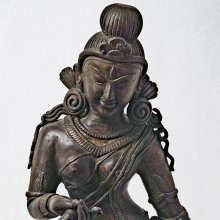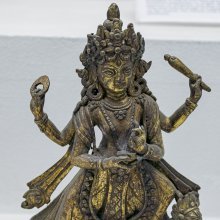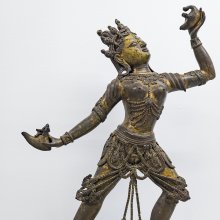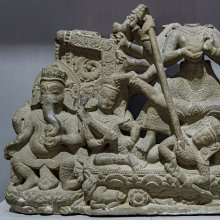Pratyalidhasana, Pratyālīḍhāsana, Pratyalidha-asana: 2 definitions
Introduction:
Pratyalidhasana means something in Buddhism, Pali, Hinduism, Sanskrit. If you want to know the exact meaning, history, etymology or English translation of this term then check out the descriptions on this page. Add your comment or reference to a book if you want to contribute to this summary article.
Images (photo gallery)
In Hinduism
Shilpashastra (iconography)
Source: Shodhganga: The significance of the mūla-beras (śilpa)Pratyāliḍhāsana (प्रत्यालिढासन) is another name for Pratyālīḍha, a type of posture (āsana) similar to the ālīḍha-maṇḍala in Bharatanatyam, as defined according to texts dealing with śilpa (arts and crafs), known as śilpaśāstras. In the pratyālīḍhāsana, the arms and legs of ālīḍha have to be interchanged.

Shilpashastra (शिल्पशास्त्र, śilpaśāstra) represents the ancient Indian science (shastra) of creative arts (shilpa) such as sculpture, iconography and painting. Closely related to Vastushastra (architecture), they often share the same literature.
In Buddhism
Tibetan Buddhism (Vajrayana or tantric Buddhism)
Source: OSU Press: Cakrasamvara SamadhiPratyālīḍhāsana (प्रत्यालीढासन) is the counter posture to ālīḍha, according to the Saṃvaramaṇḍala of Abhayākaragupta’s Niṣpannayogāvalī, p. 45 and n. 145; (Cf. Cakrasaṃvaratantra, Gray, David B., 2007).—Vajravārāhī appears both with Cakrasaṃvara, and on her own, both as Vajravārāhī and Vajrayoginī. [...] Vajrayoginī is in pratyālīḍhāsana, the counter posture to ālīḍha, indicating an aggressive feminine Buddha nature, and is pouring the amṛita from her kapāla into her mouth, savoring her own bliss. Vajravārāhī and Vajrayoginī are both red, nagnā, "naked", have muktakeśā, "loosened hair", one face and two arms, three eyes, holding a kartika in the right hand, and kapāla in the left, a garland of fifty dried human skulls, five bone ornaments, a crown of five skulls, and hold a khaṭvāṅga. [...]. Both Vajravārāhī and Vajrayoginī have their own iconographic meanings with and without Cakrasaṃvara.

Tibetan Buddhism includes schools such as Nyingma, Kadampa, Kagyu and Gelug. Their primary canon of literature is divided in two broad categories: The Kangyur, which consists of Buddha’s words, and the Tengyur, which includes commentaries from various sources. Esotericism and tantra techniques (vajrayāna) are collected indepently.
See also (Relevant definitions)
Partial matches: Asana, Pratyalidha.
Full-text: Pratyalidha, Vajrayogini.
Relevant text
No search results for Pratyalidhasana, Pratyālīḍhāsana, Pratyalidha-asana, Pratyālīḍha-āsana; (plurals include: Pratyalidhasanas, Pratyālīḍhāsanas, asanas, āsanas) in any book or story.



